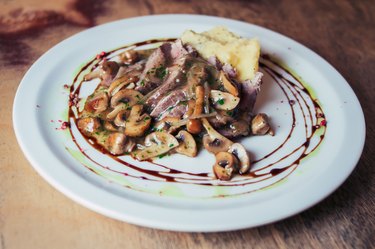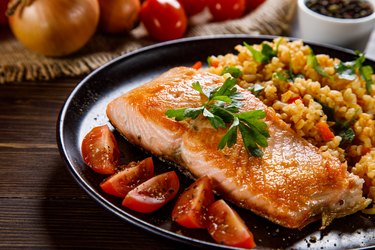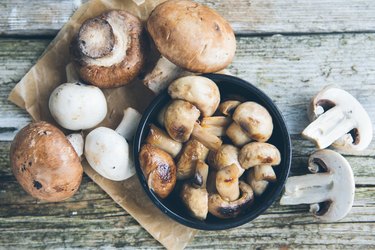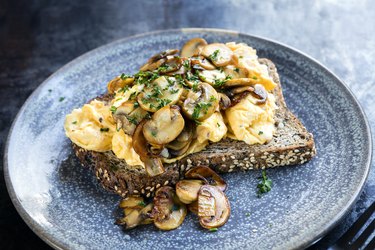Riboflavin, aka vitamin B2, is a water-soluble nutrient that helps with energy production as well as the development, growth and function of cells and the metabolism of fat and medications, per the National Institutes of Health (NIH).
Riboflavin is made up of two different parts: ribose and flavin. Ribose, also known as d-ribose, is a simple sugar naturally found in the mitochondria of cells, per a May 2018 report in Advances in Bioscience and Clinical Medicine. Meanwhile, the flavin part refers to pigments found in plant and animal tissue, per Britannica.
Video of the Day
Video of the Day
Potential d-ribose benefits include improved athletic performance, decreased muscle soreness and improved heart function in people with congestive heart failure, per the May 2018 report. Plus, some research has found that riboflavin supplements can help prevent migraine headaches in some people, but more research is needed, per the NIH.
How Much Riboflavin Do You Need?
The Recommended Dietary Allowance, or RDA, tells us how much of a nutrient we should eat every day. RDAs determine the average daily intake level that will meet the nutrient needs of most people.
The RDA for vitamin B2 is 1.3 milligrams per day for adults assigned male at birth and 1.1 milligrams per day for adults assigned female at birth, per the NIH.
Needless to say, getting enough riboflavin is essential for life! Lucky for us, this vitamin is found in a variety of foods and added to several food products and supplements.
Here are 10 foods highest in ribose and riboflavin. Note that the FDA's Daily Value (DV) percentages below are based on eating 1.3 milligrams per day.
1. Lamb Liver: 3.9 mg, 300% Daily Value (DV)

Lamb's liver is the best source of riboflavin, with 300 percent of your DV in just 3 ounces cooked. It's also incredibly high in vitamin A — a nutrient that's vital for healthy skin and vision — with 735 percent of your DV per serving.
2. Beef: 0.8 mg, 56% DV
Beef is a great source of protein, iron and B vitamins. A 3-ounce serving of skirt steak has 56 percent of your DV for vitamin B2. Choose lean cuts of red meat like sirloin steak and tenderloin to cut down on saturated fat and calories.
Beef is also an excellent source of selenium, which works together with iodine for a healthy thyroid, according to the Harvard T.H Chan School of Public Health. Both nutrients are needed in the right amount — as too much of one can create a deficiency in the other.
3. Milk: 0.9 mg, 69% DV
Milk does the body good in more ways than one: It can help improve bone growth and strength in children while preventing the onset of osteoporosis, per the USDA. The benefits come from protein, calcium, vitamin D and many B vitamins, including vitamin B2.
A 16-ounce glass of 2 percent milk has 69 percent of your DV for riboflavin. If you choose to avoid dairy milk, the USDA includes fortified soy milk in the dairy group as their nutrient profiles, including riboflavin, are similar.
4. Salmon: 0.8 mg, 64% DV

This heart-healthy fatty fish is known as a great source of omega-3 fatty acids but it's also an excellent source of several B vitamins. A 6-ounce fillet of cooked salmon provides 64 percent of your DV for vitamin B2.
While the health benefits of salmon are undeniable, there is some concern about the toxins and pollutants like polychlorinated biphenyls (PCBs) found in farmed fish. One way to reduce your exposure to PCBs is to broil, bake or grill salmon so that the fat (where the PCBs are stored) can run out and off the fish, per the Environmental Working Group.
5. Pork: 0.6 mg, 49% DV
Six ounces of broiled pork tenderloin has 49 percent of your DV for riboflavin. Not all cuts of pork are equal in nutrition, so choose lean tenderloin or chops over bacon and processed ham to save on fat and sodium.
Try this roast pork tenderloin for dinner tonight served with salad and baked sweet potato for a delicious, balanced dinner.
6. Yogurt: 0.6 mg, 44% DV
If you're not a fan of drinking milk, yogurt is a delicious alternative to get the benefits of dairy. One cup of non-fat yogurt has 44 percent of your DV for vitamin B2.
Plus, yogurt is a great source of probiotics, aka bacteria that support our health by helping digest food, limiting the bad bacteria in our bodies and keeping invaders from entering the bloodstream through the stomach lining, according to the Cleveland Clinic.
Tip
Flavored yogurt is notorious for having high amounts of added sugar, so buy plain yogurt and add fruit to naturally sweeten it yourself!
7. Mushrooms: 0.5 mg, 36% DV

One cup of cooked white button mushrooms has 36 percent of your DV for riboflavin.
Mushrooms are also a great source of vitamin B5, or pantothenic acid, with 67 percent of your DV per cup. Vitamin B5 is an essential nutrient needed to help turn food into energy, according to the NIH.
8. Spinach: 0.4 mg, 33% DV
While it may seem like it takes 10 gallons of fresh spinach to get 1 cup of cooked spinach, the results are worth it. A cup of cooked spinach has 33 percent of your DV for riboflavin.
Spinach is also an excellent source of iron and vitamin C. Vitamin C helps the body absorb iron from plant foods, per the Michigan State University Extension.
9. Almonds: 0.3 mg, 25% DV
One ounce of almonds has 25 percent of your DV for vitamin B2. Almonds and other nuts are nutrient-dense with healthy fats and protein. Pair 1 ounce of almonds with an apple or grapes for a tasty balanced snack!
10. Eggs: 0.2 mg, 18% DV

If you've been tossing out the yolk to save on calories and cholesterol, you might want to think twice. While eggs whites hold most of the protein, the yolk is where many of the vitamins are. You'll get 18 percent of your DV for vitamin B2 in one large egg.
If you're worried about egg yolks and your cholesterol, new research may help put your mind at ease. A meta-analysis that looked at over 200,000 people's intake and health outcomes found no association between heart disease risk and eating up to one egg per day, according to a January 2020 review in The BMJ.
- National Institutes of Health: "Vitamin A"
- Harvard T.H Chan School of Public Health: "Selenium"
- USDA My Plate: "Dairy"
- Environmental Working Group: "PCBs in Farmed Salmon"
- Clevland Clinic: "Probiotics"
- NIH: "Pantothenic Acid"
- The BMJ: "Egg consumption and risk of cardiovascular disease: three large prospective US cohort studies, systematic review, and updated meta-analysis"
- Michigan State University Extension: "Iron and vitamin C: the perfect pair?"
- NIH: "Riboflavin"
- Advances in Bioscience and Clinical Medicine: "Understanding D-Ribose and Mitochondrial Function"
- USDA: "Riboflavin"